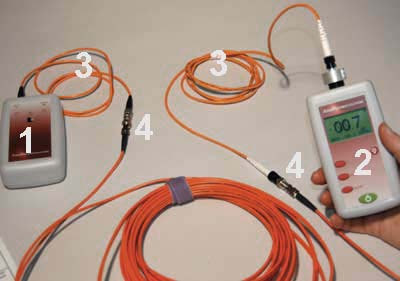High-tech fibre testing equipment analyzes defects and maintains fibre integrity.
Wiki Article
The Function of Optical Fiber Testing in Ensuring Top Quality and Efficiency in Connection Solutions
In today's quickly developing digital landscape, the significance of optical fiber screening can not be overemphasized, as it serves as a foundation for making sure the top quality and performance of connectivity options. As modern technology continues to development, the future of optical fibre screening poses appealing challenges and opportunities that merit closer assessment.Significance of Optical Fiber Testing
The importance of optical fibre screening can not be overstated in making sure the honesty and efficiency of communication networks. As the foundation of contemporary telecommunications, optical fibres promote high-speed information transmission, making their reliability crucial to operational success. Examining serves as a positive procedure to determine prospective concerns such as signal loss, depletion, and physical damages, which can jeopardize network performance.Regular screening enables the verification of installment quality and the detection of defects that might influence information stability - ofda. By utilizing extensive testing procedures, network drivers can minimize the threats related to network failures, including downtime and financial losses. Additionally, optical fibre screening ensures conformity with sector standards and guidelines, boosting the total high quality of solution supplied to end-users.
Ultimately, the methodical analysis of optical fibers adds to the durability and performance of communication systems. It enables stakeholders to make informed choices regarding upkeep, upgrades, and troubleshooting. In a landscape where information is progressively crucial, prioritizing optical fiber screening is crucial to maintaining durable and effective connectivity remedies, thereby sustaining the needs of contemporary digital settings.
Types of Optical Fibre Examinations
Numerous screening approaches are used to make sure the performance and reliability of optical fibers within interaction networks. These examinations can be broadly categorized into two primary kinds: setup examinations and maintenance tests.Setup tests are carried out immediately after the installment of optical fibre cable televisions to confirm their performance and stability - fibre testing equipment. One of the most typical installment tests consist of Optical Time-Domain Reflectometry (OTDR) tests, which evaluate the top quality of the fiber by recognizing faults or breaks, and end-to-end loss examinations, which gauge the total optical loss from one end of the fibre to the other
Maintenance tests, on the other hand, are executed occasionally to make certain recurring efficiency and spot possible concerns gradually. These include aesthetic inspection, which checks for physical damages or incorrect installations, and connection examinations, which confirm that the signal can pass via the fibre without interruption.
In addition, progressed examinations such as Polarization Setting Dispersion (PMD) and Chromatic Dispersion (CD) examinations can be carried out to review the fiber's performance under different problems. By employing these diverse screening approaches, specialists can keep high criteria of top quality and integrity in optical fibre networks.
Benefits of Regular Evaluating
Normal screening of optical fibres plays a vital role in keeping the overall performance and integrity of communication networks. By conducting normal analyses, organizations can make sure that their fiber optic setups satisfy industry criteria and operate successfully. This proactive approach helps to identify prospective weak points and destruction over time, permitting prompt treatments prior to issues escalate.
Cost-effectiveness is another advantage. By addressing small problems early, organizations can avoid the high expenses connected with major repair services or system failings. Regular screening likewise fosters conformity with regulatory demands, making certain that the network sticks to necessary safety and efficiency requirements.
Typical Concerns Determined
Identifying usual issues in optical fiber networks is crucial for preserving optimum performance and reliability. Different variables can add to interruptions, consisting of physical damages, bad installation methods, and ecological influences.Physical damages, such as bends, breaks, or abrasions, can considerably degrade signal quality. Incorrect setup strategies, consisting of too much stress or insufficient protecting of cables, might result in enhanced attenuation and loss of connection. Furthermore, ecological variables such as temperature changes, moisture access, and rodent interference can endanger the integrity of the fibre.
Connector problems additionally frequently develop, with incorrect alignment or contamination causing enhanced insertion loss. Splicing errors can introduce significant signal destruction if not implemented with precision.

Attending to these typical concerns through routine optical fiber screening not just enhances network integrity yet likewise enhances total performance, making certain that connection remedies remain durable and efficient.
Future Fads in Testing
As the need for high-speed connection continues to climb, the future of optical fiber screening will progressively concentrate on automation and advanced analytics. The integration of expert system (AI) and artificial intelligence (ML) in screening procedures will allow much more efficient information analysis and anticipating maintenance, minimizing downtime and enhancing total network reliability. Automated screening solutions will certainly enhance the examination and accreditation of fiber networks, minimizing human error and enhancing screening throughput.An additional substantial fad is the adoption of remote screening modern technologies. As the implementation of fibre networks broadens into remote and underserved locations, remote screening capacities will enable specialists to keep an eye on and diagnose network conditions without physical visibility, thus minimizing functional prices and boosting action times.
Additionally, there will be a shift towards even more extensive testing standards that encompass not just typical robotic vision loss measurements however likewise efficiency metrics such as latency and transmission capacity application. This alternative strategy will assist in much better network management and optimization methods.
As these trends progress, the optical fibre screening landscape will not just boost the top quality and performance of connectivity remedies yet also support the expanding complexities of contemporary communication networks.
Final Thought
In conclusion, optical fibre testing serves as a fundamental part in keeping the stability and efficiency of interaction networks. The recurring commitment to normal testing not only boosts data transmission yet likewise aligns with industry standards, promoting reliability in network frameworks.Report this wiki page